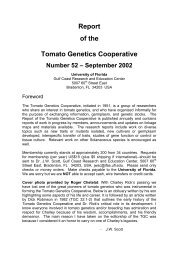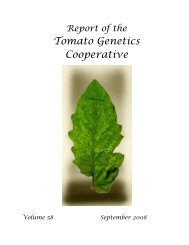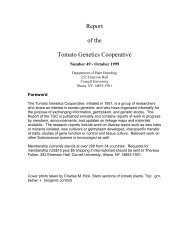Volume 60 - Tomato Genetics Cooperative - University of Florida
Volume 60 - Tomato Genetics Cooperative - University of Florida
Volume 60 - Tomato Genetics Cooperative - University of Florida
Create successful ePaper yourself
Turn your PDF publications into a flip-book with our unique Google optimized e-Paper software.
esistant lines, a specific bitter taste with lasting burning sensation, and it was used by<br />
Borchers & Nevin (1954) for setting up a quantitative chemical test <strong>of</strong> the alkaloids<br />
responsible <strong>of</strong> this taste. Another source <strong>of</strong> resistance, S. lycopersicum „Mulua‟ from<br />
Guatemala, is mentioned by Winstead & Kelman (1952) and by Suzuki et al. (1964)<br />
[who refer to Winstead & Kelman (1952) as well as to a personal communication <strong>of</strong> D.E.<br />
Ellis]. According to Winstead & Kelman (1952), „Mulua‟ yielded resistant breeding<br />
material after an initial cross with „Rutgers‟. Suzuki et al. (1964, p.99) still referring to<br />
Winstead & Kelman (1952), mention also a „T-141‟ from Puerto Rico as another source<br />
<strong>of</strong> resistance used in North Carolina, though these latter authors mention „T414‟ and not<br />
„T-141‟. The identity <strong>of</strong> „T-141‟ is henceforth doubtful, either a mistyping <strong>of</strong> „T414‟ by<br />
Suzuki et al. (1964) or another line not reported in any other source we found.<br />
To sum up, the cherry tomato „PI 129080‟ (=T 702) from Colombia, the pear shaped<br />
tomato „Beltsville No. 3814‟ (=T 414) and the tomato „Mulua‟ from Guatemala, have<br />
been included in NC breeding programs as genitors <strong>of</strong> bacterial wilt resistance.<br />
„Venus‟ and „Saturn‟, released in the early 1970s (Henderson & Jenkins, 1972a & b)<br />
are the best known commercial varieties with resistance to bacterial wilt issued from the<br />
North Carolina State program. Their pedigrees are provided in Fig. 2, and their<br />
phylogenic relationship with two other NC lines, „MR4‟ and „NC 72 TR 4-4‟, is provided<br />
in Fig.3.<br />
Hawaii<br />
D.C. McGuire, J.C. Gilbert and J.C. Acosta (breeders) as well as I.W. Buddenhagen<br />
(pathologist) are among the scientists having worked on tomato resistance to bacterial<br />
wilt in the course <strong>of</strong> the 1950s and 19<strong>60</strong>s. Breeding for resistance in commercial type<br />
tomatoes was confined first (prior to 1955) to crossing root knot nematode resistant<br />
Hawaii lines and North Carolina bacterial wilt tolerant lines (Acosta et al., 1963, 1964).<br />
Acosta (1963) indicated that several North Carolina lines which had been bred for<br />
bacterial wilt resistance, proved to be intermediate in wilt susceptibility under Hawaiian<br />
conditions. In 1953 a new source <strong>of</strong> resistance, S. pimpinellifolium „PI 127805A‟,<br />
originating from Peru, was “obtained” [sic] 5 and field selected in Hawaii through 9<br />
generations (Acosta et al., 1964). This accession would be at the origin <strong>of</strong> the line<br />
„5808-2‟ (Mohanakumaran et al., 1967). Acosta (1963) writing the name as „HES 5808-<br />
2‟, mentions that it is an inbred line <strong>of</strong> L. pimpinellifolium obtained by D.C. McGuire, but<br />
he does not refer to any PI number. The commercial variety „Kewalo‟ (Fig. 4),<br />
developed by Gilbert et al. (1974), recombines the resistance to bacterial wilt originating<br />
from „PI 127805A‟ with root-knot nematode resistance(gene Mi) and other useful traits<br />
from „Anahu‟, a local tomato, and its derivative „Kalohi‟.<br />
„Hawaii 7996‟ (H7996), „Hawaii 7997‟ (H7997) and „Hawaii 7998‟ (H7998) were later<br />
bred by J.C. Gilbert in the 1970s (Scott et al., 2005) and it has been reported in the<br />
literature (Hanson et al., 1998; Balatero & Hautea, 2001; Scott et al., 2005) that these<br />
lines had resistance derived from PI 127805A. However, correspondence dated<br />
October 1983 from J. Tanaka (Assistant Horticulturist at Hawaii <strong>University</strong>) to J. Scott<br />
indicates that the 3 mentioned Hawaiian lines and five others („H7975‟, „H7976‟,<br />
„H7981‟, „H7982‟, „H7983‟) are sister lines selected from a initially highly variable<br />
5 The word “obtained” in this sentence is quite imprecise, since it might mean “received from someone” or<br />
“obtained by breeding”.<br />
9





